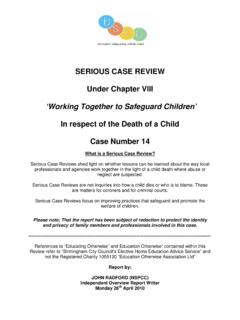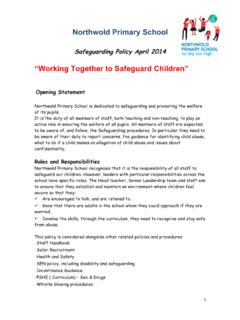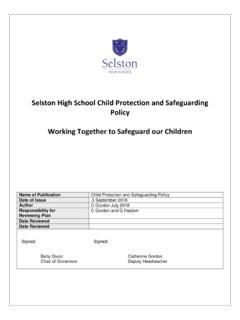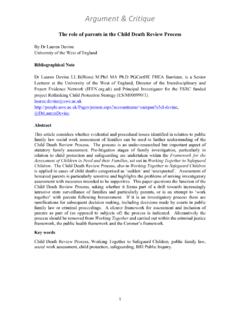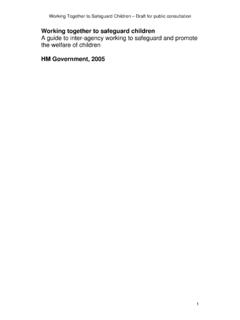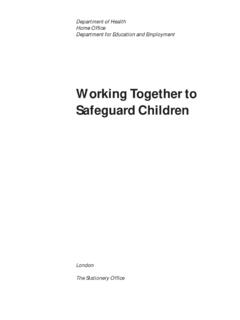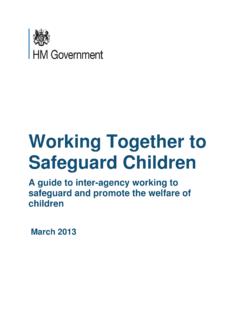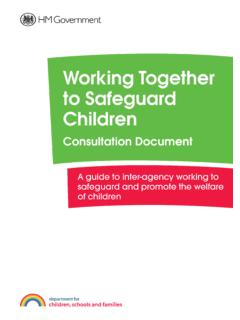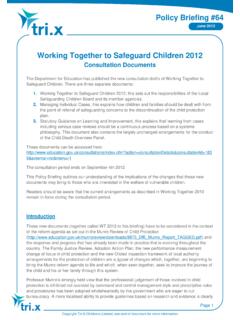Transcription of NSPCC response to Working together to safeguard children ...
1 The NSPCC response to Working together to safeguard children : safeguarding children from Abuse linked to a belief in Spirit Possession and Witchcraft NSPCC March 2007. 42 Curtain Road London EC2A 3NH. Telephone: 020 7825 1352. Fax: 020 7825 2964. Website: 1. Introduction The National Society for the Prevention of Cruelty to children ( NSPCC ) is the UK's leading charity specialising in child protection and the prevention of cruelty to children . The NSPCC aims to end cruelty to children by seeking to influence legislation, policy, practice, attitudes and behaviours for the benefit of children and young people. This is achieved through a combination of service provision, lobbying, campaigning and public education. The NSPCC believes that, given the will, all cruelty can be prevented. In order to achieve this, it is vital that all children , whatever their needs, have a range of services that are flexible and offer them support and protection.
2 The NSPCC has more than 180 services in the UK and the Channel Islands. These services aim to: Prevent children being abused by Working with parents and carers in vulnerable families to improve their knowledge and skills in safeguarding , and giving children and young people someone to turn to through the provision of our Listening Services. Protect vulnerable children and young people from abuse by providing direct services in a number of settings, including schools and young people's centres. We also protect them by providing Listening Services for adults to ensure they have someone to turn to with their concerns; by ensuring that abused children and young people are identified and effective action is taken to protect them, and by Working with young people and adults who pose a risk to children and young people to reduce the risk of abuse. Help children and young people who have been abused overcome the effects of abuse and achieve their potential.
3 In drawing together this consultation we have consulted with NSPCC . practitioners who have worked with children who have been abused as a result of a belief in spirit possession and/or witchcraft. This includes abuse linked to beliefs in Celtic witchcraft, spirit possession and witchcraft in Black African communities, and exorcism and deliverance ministry in the Church of England. We have also drawn on the experience of our training and consultancy staff who have provided advice and consultancy services to a number of different faiths and religious denominations. We have consulted with our Local safeguarding children Board (LSCB) Adviser and with staff who are members of LSCBs. We also sought the views and advice of the NSPCC 's Child Protection Awareness and Diversity Department which seeks to raise awareness and influence the attitudes, behaviour, practice and policies of a number of audiences, including children and young people, parents, all adults, and professionals.
4 The team includes specialist posts that promote diversity and equality by promoting the needs of children and families from black and minority ethnic groups and disabled children . 2. Summary of key points We welcome the Department for Education and Skills guidance on safeguarding children from Abuse linked to a belief in Spirit Possession. The guidance is a useful and much-needed supplement to Working together to safeguard Children1. It is a detailed resource bringing together information, indicators and best practice for practitioners who come into contact with children abused or neglected because of a belief in spirit possession and witchcraft. Abuse linked to a belief in spirit possession and witchcraft is a clear violation of a child's rights. In particular, it is contrary to Article 2 of the United Nations Convention on the Rights of the Child (UNCRC) which states that all appropriate measures shall be taken to ensure that the child is protected against all forms of discrimination or punishment on the basis of the status, activities, expressed opinions, or beliefs of the child's parents, legal guardians, or family members.
5 The UNCRC must be the starting point of dealing with cases and it would be helpful for the guidance to be framed by Article 2 of the UNCRC to clearly set out that all children must be protected from harm because of a belief in spirit possession and witchcraft. The draft guidance states that the number of cases of abuse known to be linked to a belief in spirit possession and witchcraft is small compared to the total number of children known to be abused as whole. However, although the number of identified cases is low, the type of abuse is particularly disturbing and the impact on the child is substantial and can have serious implications for them in later life. It is essential that practitioners should be equipped to identify cases, be familiar with definitions and practices associated with abuse because of a belief in spirit possession and witchcraft and know what to do if they suspect a child is being abused or neglected because of these beliefs.
6 However, we do not consider that the guidance alone is sufficient to tackle this issue. To ensure practitioners are able to protect children being abused because of a belief in spirit possession and witchcraft, it is essential that this draft guidance is accompanied by training and resources to ensure that staff are able to recognise and respond to this type of abuse. Given the recent failures to prosecute individuals who are arguably inciting abuse by labelling children as witches, we consider that new legislation to tackle the harm caused to children by a belief in spirit possession and witchcraft may also be needed. New legislation could be used to raise awareness and act as an educational tool in communities where this type of abuse is prevalent that it is unacceptable and will not be tolerated. We are currently examining various options for how this could be drafted and would welcome further discussion with the Department for Education and Skills in due course.
7 1. HM Government (2006) Working together to safeguard children : a guide to interagency Working to safeguard and promote the welfare of children HM Government, London 3. We are particularly concerned that the draft guidance lacks detail about the increased vulnerability of a child with a difference as a trigger for a belief that they are possessed with a spirit or a witch. We suggest that disability, a child with a difference (such as being exceptionally bright) and a weak bond of affection between the carer and the child is clearly stated in the guidance as a key factor and feature in contributing to abuse perpetrated on a child because of a belief in spirit possession and witchcraft. response to specific questions Do you agree with these key considerations? We agree with the key considerations set out in the guidance. However, we suggest a number of additions to the text.
8 These include: ii. All people Working or in contact with children have a responsibility to recognise and know how to act on evidence We recommend that after the word evidence', the words concerns and signs'. are added. The word evidence, by itself, denotes a legal tone and suggests that physical evidence must be available before people Working , or in contact, with children act if a child's health, development and safety is being harmed or impaired. It is important that anyone Working or in contact with children acts immediately on any concerns or on evidence that a child is being harmed. iii. Standard child safeguarding procedures apply and must always be followed Although this point refers to Working together which provides the framework for statutory guidance, we suggest that a sentence is added clearly stating that any concerns about a child being abused should trigger an inquiry as set out in Section 47 of the children Act 1989.
9 Iv. Child abuse linked to a belief in spirit possession often stems from a child being used as a scapegoat While we do not dispute that this may be the case, the guidance is very limited in detail about the increased vulnerability of a child with a difference as the trigger for a belief that they are possessed with a spirit or a witch. We suggest that disability, a child with a difference (such as being exceptionally bright) and a weak bond of affection between the carer and the child are added to this consideration. Research by the Department for Education and Skills, published in 2006. found that disability is a key factor that leads to children becoming vulnerable and at greater risk of abuse due to a belief in spirit possession and witchcraft. The report commissioned by the Department for Education and Skills2 stated that certain characteristics or behaviour including disability, illness or a child 2.
10 Stobart, E (2006) Child Abuse Linked to Accusations of Possession and Witchcraft Department for Education and Skills, London 4. with a difference' were common features in abuse cases linked to a belief in spirit possession. The report also stated that several factors combine to make a child more at risk, including rationalising misfortune and a change of circumstances for the worse. When family troubles begin or are exacerbated such as serious illness, financial troubles, or unemployment, people may look for anything that is new or 'different' as the cause of the problem. vi. Professionals with safeguarding responsibilities should be able to identify links Professionals, local agencies and institutions should, as a matter of good practice, improve their knowledge about families and learn to identify beliefs that may lead to harmful behaviour towards children .
